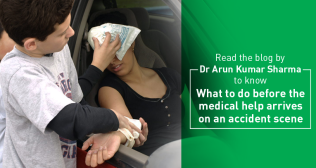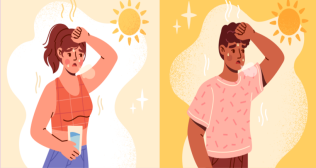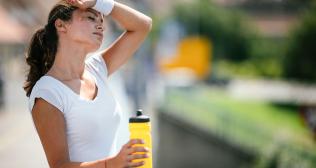 First-aid is defined as an emergency care given to the ill or injured before regular aid can be obtained. To prevent harm and preserve life, an early assistance or intervention may be required. Learn and save these handy tips.
T
First-aid is defined as an emergency care given to the ill or injured before regular aid can be obtained. To prevent harm and preserve life, an early assistance or intervention may be required. Learn and save these handy tips.
There are more emergencies happening at home and workplace than elsewhere. Fortunately most of them do not required distinctive medical care in the hospital. But unfortunately most of us are neither trained nor geared up to tackle emergencies or perceived emergencies.
First aid would, therefore, imply the following:
• Recognition of life threats
• Imparting the right assistance and intervention
•Awareness of injury-to-intervention time.
Chest pain
This would normally imply a
heart attack to many of us. Not all chest pains are heart attacks, but no chest pain should be ignored especially if you are in a vulnerable category. Blood pressure, diabetes, smoking, diet, bad fats and obesity and high sodium in the blood affect all genders, and are risk factors for those who are as young as 30 years in age. The warning signs of heart attack are pain in the chest (mostly, neck, arm and back occasionally) and associated bloating, shortness of breath, cold sweat and nausea. Those in the risk group should not ignore chest pain. Relax, sit-down, call an ambulance and do not drive yourself. Time is essential, do not procrastinate for the next morning. A tablet of aspirin will help you if you cannot reach hospital early.
Allergy & Anaphylaxis
Allergy is a body’s response to a substance to which it has become hypersensitive. Asthma and eczema could be one end of the spectrum, while intolerance to a particular food may be the other. Most allergies are predictable and short lived, and may take the form of running nose, diarrhoea and itching skin depending on the allergies.
The more important aspect is preparedness. It is good to know about:
• Your and your family allergies
• You need to avoid the trigger-allergies e.g. fish, pollen house dust, drug or any other.
• You need to prominently document/display them at your home/ office / school.
• You should have consulted your physician on you allergy, earlier.
Insect bites also produce allergy, mostly minor, lasting for a few hours. Bee hornet and wasp stings may be very painful.
All bees leave their sting in the wound. The sting has to be removed immediately. If can be scraped off by a paper, pulled out by hand or even a tweezers, but it has to be done quickly. Cold compresses and anti - histamines do help in the pain and swelling that follows. There are people who are high-allergics, and they can suffer from anaphylaxis (serious and severe allergic reaction).
Paralysis /Stroke
There may be some vulnerable group as the same as for heart attack and they suffer a possible stroke. FAST (face droop, arm weakness, trouble seeing speech difficulty, confusion) trouble understanding severe headache without cause. Nothing can be done at home. Call an ambulance, explain the symptoms and rush the patient to a specialised stroke centre within the golden hour (60 minutes from the onset of stroke). A specialised stroke centre can abort your stroke.
Choking
Most people have choked many times in their life. Most of us choke on rice, small peanuts, while drinking water, and so on. Serious choking occurs when large bolus of food, bones, coins, get stuck and it is impossible to breathe. Small objects still leave a lot of space for air to go to the lungs. However, serious choking needs intervention.
Choked individuals first start coughing (let them cough) then their voice becomes hoarse but they are still conscious and breathing and finally they stop breathing become unconscious and start turning blue.
Back blows between the shoulder blades by your hand is advocated as long as the patient is conscious and breathing. However, as soon as the patient seems to be stopping to breathe, a time tested manoeuvre (heimlich’s) is advocated:
• Stand behind the patient
• A two handed fist is made and placed above the belly button
• Then you pull inwards and upwards (up to five thrusts) towards your self.
Caution: Do not practice this on individuals, use a pillow instead to learn this manoeuvre

 First-aid is defined as an emergency care given to the ill or injured before regular aid can be obtained. To prevent harm and preserve life, an early assistance or intervention may be required. Learn and save these handy tips.
First-aid is defined as an emergency care given to the ill or injured before regular aid can be obtained. To prevent harm and preserve life, an early assistance or intervention may be required. Learn and save these handy tips.
















